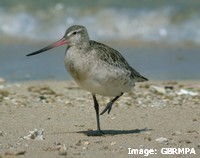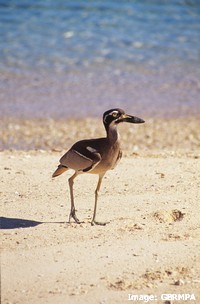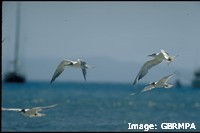






















Shorebirds
Migratory shorebirds
These are a group of birds included by scientists in the order Charadriiformes, which live and feed in the intertidal zone. They live by the tides, feeding on the intertidal flats when the tide is out and roosting together on the shore when the tide comes in. They are well camouflaged to match their shoreline habitats.
These 'nondescript' brown birds that we see roosting along our shores in the summer months are capable of some remarkable feats. The smallest to visit our region are the Red Necked Stints, the size of a chicken egg and weighing in at about 25g, yet they complete a round trip of up to 20,000 kilometres every year, between their feeding areas in Australia and breeding areas in the Arctic.
Life on the edge
Migratory shorebirds spend the Australian summer feeding on the coast, leaving in March to fly all the way to Northern Siberia and Alaska to breed and returning to Australia between late August and October. To prepare for these epic journeys, they spend their time in Australia feeding on animals like worms, snails and bivalves, stocking up on reserves of fat and protein to fuel days of non-stop flying.
The feeding technique and beak shape of each species is adapted to allow them to target particular prey animals. The birds increase their body weight by between 30% and 70% during this time, depending on the species. Every moment of feeding is critical for them to build up enough reserves to make their migration; disturbing these birds while they are feeding uses up vital energy and feeding time and can threaten their survival.
Seasoned travellers
The routes they follow are called Flyways, and like human air travellers, they depend on stopover sites, where they rest and refuel with high-energy food. They use up to 1g of bodyweight each day in their continuous flight, sleeping on the wing with alternate halves of their brains and navigating by the Earth’s magnetic field.
The East Asian–Australasian Flyway runs from Siberia and Alaska down through east and south-east Asia to Australia and New Zealand, traversing 22 countries. This flyway is travelled by over 5 million birds from 55 species.
Endless summer
Migratory waders migrate all that way to take advantage of huge amounts of available food in the form of insects that thrive in the short summer in the Arctic region. This rich food source allows them to breed and raise their chicks quickly. The chicks can look after themselves by about 6-8 weeks old and the adults then leave for the Southern Hemisphere to escape the harsh winter.
The chicks feed frantically, increasing their weight at an incredible 2-5% per day, readying themselves for their first migration before the snows set in. Once they reach Australia, young birds spend 4-5 years here before their first breeding migration.
Migratory waders of the Whitsunday Region:
- Bar-tailed Godwit Limosa lapponica
- Black Winged Stilt Himantopus himantopus
- Black-tailed Godwit Limosa limosa
- Broad-billed Sandpiper Limicola falcinellus
- Common Greenshank Tringa nebularia
- Common Sandpiper Actitus hypoleucos
- Curlew Sandpiper Calidris ferruginea
- Double-banded Plover Charadrius bicinctus (breeds in New Zealand)
- Eastern Curlew Numenius madagascariensis
- Great Knot Calidris tenuirostris
- Greater Sand Plover Charadrius leschenaultia
- Grey Plover Pluvialis squatarola
- Grey-tailed Tattler Tringa brevipes
- Latham’s Snipe Gallinago hardwickii
- Lesser Sand Plover Charadrius mongolus
- Little Curlew Numenius minutus
- Marsh Sandpiper Tringa stagnatilus
- Pacific Golden Plover Pluvialis fulva
- Pectoral Sandpiper Calidris melanotos
- Red Knot Calidris canutus
- Red-necked Stint Calidris ruficollis
- Ruddy Turnstone Arenaria interpres
- Sanderling Calidris alba
- Sharp-tailed Sandpiper Calidris acuminata
- Terek Sandpiper Xenus cinereus
- Wandering Tattler Heteroscelus incanus
- Whimbrel Numenius phaeopus
Other shorebirds of the Whitsunday Region
Some species don’t go in for all that travelling and stay at home, breeding in Australia. These include species that are at risk such as the Beach Stone-curlew, Little tern and Sooty oystercatcher.
Most of these species nest between September and March, often laying eggs on the ground along foreshores, beach strandlines, and rocky shorelines on the mainland and offshore islands. Their nests and chicks are often extremely well camouflaged and hard to see. They are in danger when we walk our dogs off the leash or drive on the foreshore. Their eggs are also eaten by feral pigs, dogs, cats, foxes and rats, as well as native gulls and crows, which can increase in numbers when humans provide food for them.
- Beach Stone-curlew Esacus neglectus (resident)
- Black-naped tern Sterna sumatrana (resident)
- Black noddy Anous minutus (resident)
- Bridled tern Onychoprion anaethetus (resident)
- Caspian tern Hydroprogne caspia (resident)
- Common noddy Anous stolidus (resident)
- Common tern Sterna hirundo (breeds in Northern Hemisphere)
- Crested tern Thalasseus bergii (resident)
- Gull-billed tern Gelochelidon nilotica (nomadic)
- Lesser crested tern Thalasseus bengalensis (resident)
- Little tern Sternula albifrons (resident)
- Pied Oystercatcher Haematopus longirostris (resident)
- Red-capped Plover Charadrius ruficapillus (resident)
- Roseate tern Sterna dougallii (resident)
- Silver gull Larus novaehollandiae (resident)
- Sooty Oystercatcher Haematopus fuliginosus (resident)
- Sooty tern Onychoprion fuscata (resident)
- White-winged black tern Chlidonias leucopterus (migratory)
- White-fronted tern Sterna striata (breed in New Zealand)
Protected areas for shorebirds in the Whitsundays
Because shorebirds are so vulnerable to disturbance and egg predation, there are some areas in the Whitsundays which have restricted access to protect shorebirds. During the restriction period, keep your boat speed below 6 knots within 200 metres of a Significant Bird Site and don’t go ashore.
East Rock, Edwin Rock and Olden Rock have Boat Free Zones within 200 metres of the high water mark between 1 October and 31 December each year. Aircraft should stay more than 1500 feet above these sites during the restriction period.
Important shorebird sites in the Whitsundays
Closed All Year:
Bird Island
East Rock*
Edwin Rock*
Eshelby Island
Little Eshelby Island
Closed between 1 October to 31 March (inclusive):
Armit Island (south beach)
Double Cone Island (west island)
Grassy Island (south beach)
Little Armit Island
Olden Rock (south of Olden Island*)
Shaw Island (beach east of Burning Point)
South Repulse Island (west beach, excluding campsite
*Boat Free Zone between 1 October and 31 December each year
Threats to shorebirds
- Destruction of nests by introduced species such as feral pigs and dogs
- Disturbance and nest damage due to people, uncontrolled pets and vehicles on nesting beaches
- Frequent disturbance of migratory shorebirds when they are roosting and feeding threatens their ability to put on enough weight to complete their migrations
- Loss of wetland feeding and breeding habitat in Australia and overseas, due to coastal development
- Destruction of intertidal feeding habitats by land reclamation for marinas, resorts and ports
- Entanglement in, and ingestion of marine debris, especially plastics and discarded fishing gear
- Degradation of coastal habitats caused by water pollution from human activities on land
- Changes in sea level and storm frequency due to climate change threaten the seagrass, mangrove and wetland habitats that shorebirds depend on for food
How you can help shorebirds...
- Join a local conservation group!
- Support local programs to monitor and protect shorebird habitat, such as Seagrass Watch and Mangrove Watch
- Avoid littering the marine environment: pick up litter when you visit the beach, even if it isn’t yours!
- Water quality begins at home (and at work...)! Remember that the chemicals you use will ultimately end up in the sea. Use environmentally friendly chemicals; avoid artificial herbicides and pesticides if you can. If you have to use harmful chemicals, follow the instructions on the label carefully and avoid uses that might let chemicals wash into drains or waterways
- Be careful when walking on the shore during bird nesting season, nests and hatchlings can be hard to see. Agitated birds may have eggs or chicks nearby, keep away!
- Keep your dog under control on the beach and avoid disturbing birds nesting, roosting or feeding on the shore or intertidal
- Don’t drive vehicles in the dunes and strandline where birds nest
- Support local programs to restore and protect coastal habitats
- Support local programs to control feral animal pests
More information:
GBRMPA Responsible Reef Practices:
Get involved: report interesting bird sightings:
Volunteer groups:
Birdlife Mackay (Mackay Bird Observers Club)
Downloadable resources:
GBRMPA Tropical Topics: Shorebirds
GBRMPA Tropical Topics: Seabirds
WWF and Australian Government: Australian shorebird identification sheet
Environment Australia: Shorebird migration poster
Australian Government brochure: Harmful Marine Debris
Websites:
Queensland Wader Studies Group
Bird life Australia: Beach nesting birds
http://www.birdlife.org.au/projects/shorebirds-2020
Bird life Australia: Shorebird research and conservation
Australian Museum: Beach Stone Curlew
GBRMPA Project ReefEd: shorebirds
Bird life Australia: Birds in backyards
Ozcoasts: Shorebirds as an indicator of ecosystem health
Hunter Wetlands Centre: Feathers, flyways and friends
Asia Pacific Shorebird Network
Queensland Government: Shorebirds
Environment Australia: Migratory waterbirds
Reports:
GBRMPA: Shorebirds, A vulnerability assessment for the Great Barrier Reef


